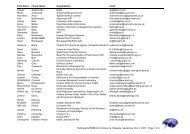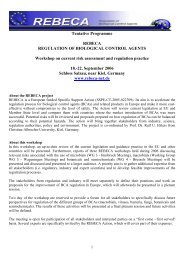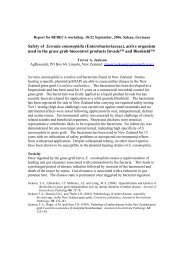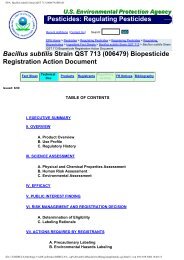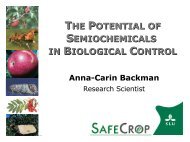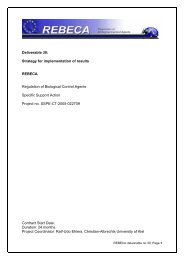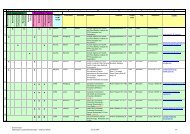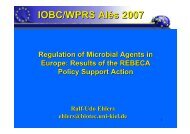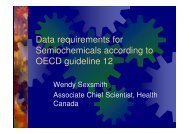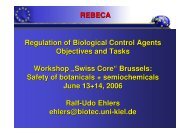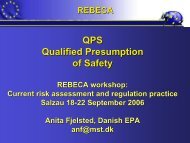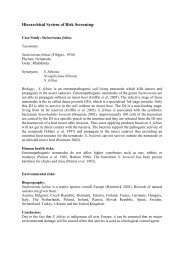Deliverable 28: Specification of low risk products REBECA ...
Deliverable 28: Specification of low risk products REBECA ...
Deliverable 28: Specification of low risk products REBECA ...
Create successful ePaper yourself
Turn your PDF publications into a flip-book with our unique Google optimized e-Paper software.
Indirect Effects. Indirect effects in this context are defined as changes in the<br />
ecosystem that are a consequence <strong>of</strong> a direct effect caused by the use <strong>of</strong> a pesticide.<br />
For instance, the reduction <strong>of</strong> pollinators will reduce the reproduction <strong>of</strong> plants that<br />
rely on these pollinators. Likewise, pesticide effects on earthworms, aquatic plants, or<br />
microbial activity will temporarily or permanently alter the ecosystem the product is<br />
applied to. Because <strong>of</strong> their indirect nature, the level <strong>of</strong> uncertainty in assessing<br />
these effects is greater than for the other components <strong>of</strong> the <strong>risk</strong> indicator system,<br />
and the assessment must mainly rely on expert judgement. However, the estimation<br />
<strong>of</strong> how severe the occurrence <strong>of</strong> a non-target effect is on an ecosystem level is<br />
considered significant for the appropriate assessment <strong>of</strong> pesticide <strong>risk</strong> to the<br />
ecosystem.<br />
Table 5. Score for indirect effects on the ecosystem. Assignments are generally<br />
based on expert judgement as indicated by the ecosystematic position <strong>of</strong> organisms<br />
affected by direct effects, and the severity <strong>of</strong> anticipated effects.<br />
Indirect Effects<br />
Score Likelihood Magnitude<br />
1 Very unlikely no significant impact on whole ecosystem<br />
2 Unlikely<br />
minor and short-term impact on parts <strong>of</strong><br />
ecosystem<br />
3 Possible<br />
significant short-term impact on parts <strong>of</strong><br />
4 Likely<br />
ecosystem<br />
significant long-term impact on parts <strong>of</strong><br />
ecosystem<br />
5 Very likely significant long-term impact on whole ecosystem<br />
Table 5 describes the scoring mechanism for indirect effects. As a general guidance,<br />
substances that score high in the host range and direct effects sections will in most<br />
cases have a higher likelihood for indirect effects.<br />
Vertebrate toxicity. We propose to apply a weighting factor to direct effects (E D ) to<br />
increase the value for non-target losses if vertebrates are affected. The weighting<br />
scheme is described in Table 6.<br />
Table 6 Factors assigned whether or not direct effects concern vertebrates.<br />
Vertebrate toxicity<br />
Factor Magnitude<br />
1 No vertebrates are affected<br />
1.5 Poikilothermic vertebrates are affected by non-target effects<br />
2 Homeothermic vertebrates are affected<br />
24



